 Movies and TV
Movies and TV  Movies and TV
Movies and TV  Humans
Humans 10 Times Scientists Were Absolutely Sure… and Absolutely Wrong
 Our World
Our World 10 Pivotal Moments for Life on Earth
 Movies and TV
Movies and TV 10 Most Realistic Medical TV Shows of All Time
 Creepy
Creepy 10 Eerie & Mysterious Ghosts of the Pacific Coast
 Weird Stuff
Weird Stuff 10 Typos That Accidentally Changed History
 History
History 10 Times Trickery Won Battles
 Technology
Technology 10 Awesome Upgrades to Common Household Items
 Misconceptions
Misconceptions 10 Hilarious (and Totally Wrong) Misconceptions About Childbirth
 Weird Stuff
Weird Stuff 10 Warning Labels That Exist Because Someone Actually Tried It
 Movies and TV
Movies and TV 10 Zombie Movies That Will Actually Terrify You
 Humans
Humans 10 Times Scientists Were Absolutely Sure… and Absolutely Wrong
 Our World
Our World 10 Pivotal Moments for Life on Earth
Who's Behind Listverse?

Jamie Frater
Head Editor
Jamie founded Listverse due to an insatiable desire to share fascinating, obscure, and bizarre facts. He has been a guest speaker on numerous national radio and television stations and is a five time published author.
More About Us Movies and TV
Movies and TV 10 Most Realistic Medical TV Shows of All Time
 Creepy
Creepy 10 Eerie & Mysterious Ghosts of the Pacific Coast
 Weird Stuff
Weird Stuff 10 Typos That Accidentally Changed History
 History
History 10 Times Trickery Won Battles
 Technology
Technology 10 Awesome Upgrades to Common Household Items
 Misconceptions
Misconceptions 10 Hilarious (and Totally Wrong) Misconceptions About Childbirth
 Weird Stuff
Weird Stuff 10 Warning Labels That Exist Because Someone Actually Tried It
8 Frightening Little-Known Facts About Tattoos
The world of tattoos appears tame. Aficionados go to a parlor, get their sleeves or tramp stamp and that is the end of it. The truth is not quite so one-dimensional. Thanks to these inky imps, people develop fake cancer, burn inside MRI machines and revenge flares up between soccer fans. Along a darker line, tattoos also tell doctors when to let patients die, can literally be given away as inheritance and in some places, persecution has driven artists and their clientele underground.
SEE ALSO: 10 Pop Culture Tattoos (And Their Secretly Ridiculous Meanings)
8 The QR Code Incident

Soccer fans can get really passionate about their favorite sport. Plenty of tattoos undoubtedly immortalize the different flags, team logos and players on various body parts. But in 2019, one soccer supporter chose a unique tattoo to showcase his love of the game.
The man inked a QR code on his leg. Initially, the square linked him to a YouTube video. The footage glorified his beloved River Plate football team from Argentina. Unfortunately, the fan made the mistake of sharing his tattoo and its purpose online. Supporters might be passionate about the game but they can be famously mean to people cheering for other teams. When a rival team’s fans spotted the QR post, they rallied in large numbers on YouTube. The pranksters reported the video and claimed that it was in violation of several copyright laws.
While this was untrue, YouTube nevertheless removed the clip – and rendered the River Plate fan’s tattoo useless. Worse, he had only been able to use it for a few hours before the video disappeared. There is a chance that the footage might one day be restored to YouTube but until then, the QR tattoo is just a mottled square of ink with no Internet magic.[1]
7 The Burnt Tattoo Mystery
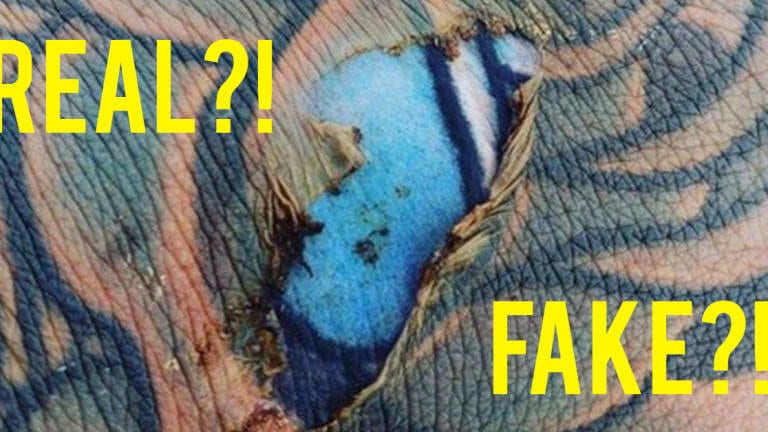
In 2018, a photograph appeared on Reddit. The image showed a kitchen-related burn on somebody’s hand – but there was no sympathy. Reddit users were too busy fighting over how real the whole thing was. The hand was adorned with a tattoo depicting a blue rose. The faded color suggested that the art was old. But underneath the scorched skin, where bits have peeled away, emerged another part of the tattoo. It was so vivid that the blue looked freshly inked.
While some users insisted that the picture was another Photoshop fake, one pointed out that similarly refreshed tattoos do show up on corpses. This is a fact. Dead bodies do something rather nauseating during decomposition. Called “skin slippage,” the top layer of skin becomes loose and falls off. In this case, the top layer was burnt off but the same principle applies. Top skin off. The tattoo looks grand again.
The problem is the bright blue. Is such an intense color refreshment even possible? By comparison, the rest looks badly faded. During its initial creation, the rose probably required a copper-based ink for the petals, and titanium or lead for the white regions. These metals require hectic conditions, including strong light and high temperatures, to fade this much. That does not mean the image is fake. The reason why skin art fade is not fully understood. Layers of skin could grow over a tattoo and “fade” what we see but deeper under the surface, the colors remain bright. Of course, it could be a hoax. The burn wound might be the only legitimate thing about this image. If this is the case, then the fresh blue was digitally added.[2]
6 Tattoos Can Mimic Cancer

Nobody adores a lump. In 2017, when an unidentified patient discovered one in each armpit, she became concerned. Her doctors were worried too. This was a classic symptom of a type of cancer called lymphoma.
The Australian woman underwent surgery to remove a lump for analysis. The body part looked a little on the putrified side. The gross view was certainly in line with what one could expect after fearing the worst. Beforehand, the medical team had noticed that the 30-year-old had no other lymphoma symptoms like sweating, weight loss or itching. When they examined the lymph node, it became clear why. The woman did not have cancer. Instead, a cancer-like reaction had been triggered in her lymph nodes by a tattoo.
The lump was engorged with immune cells that had consumed the black pigments as if they were a threat. It is not unknown for tattoo ink particles to reach lymph nodes. Indeed, there are several cases prior to this one that recorded the link between skin art and fake lymphoma of the skin and melanoma. But this was the first time such a horrendous reaction occurred within the lymph system itself. Incredibly, the tattoo was not a fresh purchase. The woman had it added to her body around 15 years ago.[3]
5 “Do Not Resuscitate”
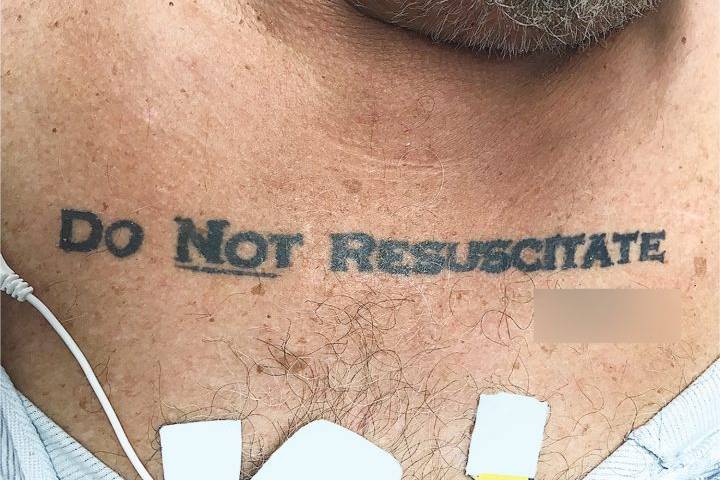
In 2017, a 70-year-old left his nursing home, got drunk and passed out in the streets of Miami. He was rushed to Jackson Memorial Hospital’s emergency room where doctors made a troubling find. Tattooed across the patient’s chest were the words, “Do Not Resuscitate.” The “Not” was underlined for emphasis and a signature nearby added more gravity to the demand.
Since the man was in critical condition, the tattoo caused more than just a little consternation. Doctors did not know how legal this end-of-life request was and whether they should honor it. The man was unconscious, had no identification and there were no friends or family that could provide more clarity on the matter.
The message seemed pretty clear but a few years ago, another man had the same tattoo but told doctors he wanted to be saved should he require medical intervention. He was forced to get the macabre message because he lost a poker bet. Fearing that the elderly Miami man also obtained his tattoo under circumstances he later regretted, the medical team decided to go ahead and keep him alive. During the hours that followed, the case was reviewed and doctors also spoke to an ethics consultant. The latter advised them to honor the patient’s tattoo and the patient died the following morning.
Social workers later found the man’s DNR paperwork and the document confirmed his wishes to die. However, despite that the doctors acted according to the patient’s wishes, ethics experts do not encourage DNR tattoos. They are not proper replacements for end-of-life documents and should doctors choose to ignore a DNR tattoo and resuscitate a patient against their will, the staff cannot be held legally accountable.[4]
4 Metallic Ink Cause MRI Burns

Metallic objects are not allowed inside an MRI machine. The device works with epic magnets. For this pulling-jewelry-from-flesh reason, a patient must remove all bling, glasses and even wire-lined underwear. Those who can remove their metals are the lucky ones. On the other hand, people with tattoos face a rare but serious risk – some dyes contain metals. As a result, a few people with body art have suffered from irritated skin and swelling.
One particularly painful incident occurred when a woman entered an MRI machine and exited with first degree burns on her eyelids. Her tattoos were not the usual kind. She had permanent makeup needled into her skin. Researchers tracked down the manufacturers of the ink used in this case. They admitted that there were several heavy metals in the dye, but no ferric oxides. The latter is the culprit suspected of causing tattoos to heat up and burn inside MRI scanners. However, since tattoo ink is unregulated by the FDA, the manufacturer might not have disclosed the presence of offending ingredients.[5]
3 Tattoo-Driven Locusts
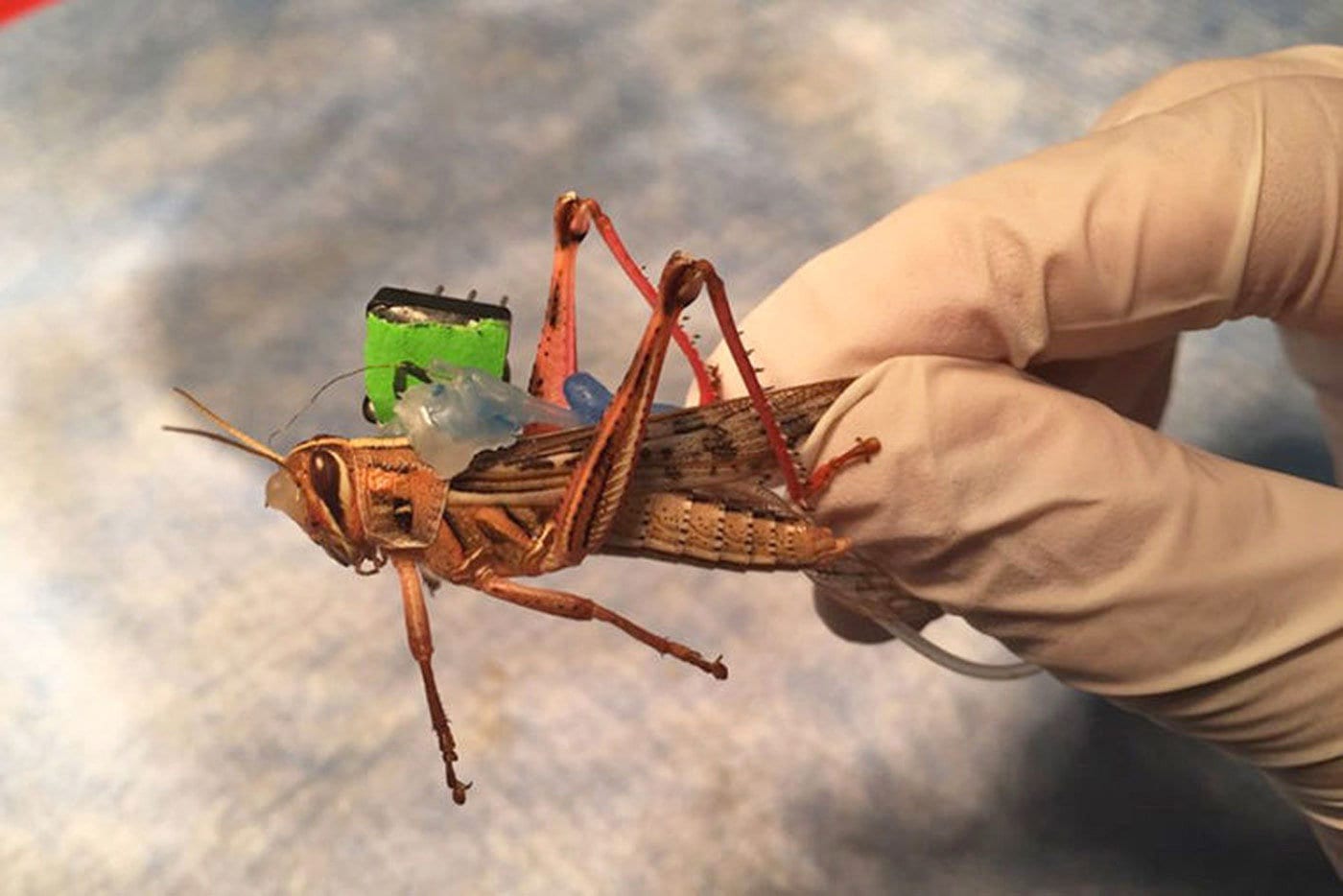
Here is a crazy thought. Why not use tattoos on a locust’s wings to steer the insect towards finding explosives? The Office of Naval Research in the United States does not think the idea is crazy at all. In 2016, the department gave scientists $750,000 (£565,000) to research the technology. It started with a bug specialist. Professor Baranidharan Raman dedicated years of his life to one thing – learning how locusts use their sense of smell. The grant was a welcome injection to continue with his peculiar study involving bomb-sniffer insects.
The tattoo is not the traditional ink type. Instead, it will consist of biocompatible silk and act as a conductor for heat. When the tattoos turn slightly warmer on the insect’s wings, this will help steer it into the desired location – like a remote place or a site possibly rigged with bombs.
Apparently, training a locust to recognize a scent is easy. Additionally, no artificial sensors can match their ability to detect this desired aroma between a host of others that do not matter. When the insect smells the chemicals its handler is looking for, neural signals enter a processing chip on its body. The information is then beamed wirelessly back to base. Although the scientists did not go into detail they said that the tattoos could also gather samples from any suspicious packages.[6]
2 Tehran’s Hidden Tattoo Artists
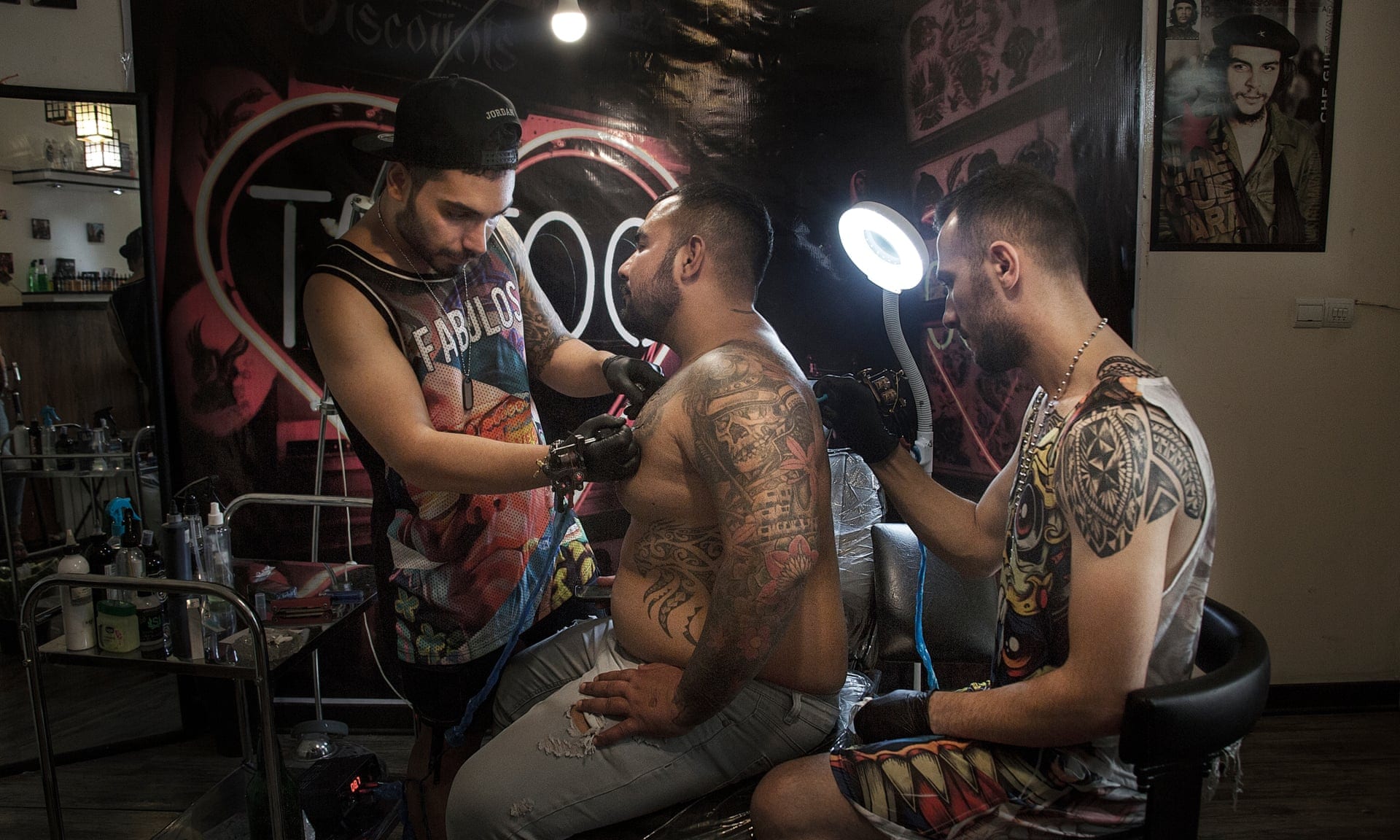
Tattoos are not globally loved by all governments. In the Iranian capital of Tehran, a person holding a tattoo machine must do so in secret. Most teach themselves the art and struggle to get decent equipment. If ousted, a tattoo artist is often arrested—despite the fact that there are no laws against tattoos. The sentence varies but popular choices include lashes, fines or jail time. Iranians who get tattoos are also persecuted. Public places have warning signs along the lines of, “If you have a tattoo, you are not welcome here.”
Despite this, the industry flourishes in hidden rooms and inside homes. Artists are driven by the passion for their craft while the clients want tattoos to express themselves as individuals, or because it makes them feel beautiful and powerful. For others, getting body art is a form of resistance against a stifling culture where self-expression is not encouraged.
Interestingly, women play a big role in the movement. Tehran has many female tattoo artists and clients. Atefeh started by practicing on her own leg before she moved on to the women who discreetly visit her home. What do Iranian women want on their bodies for eternity? According to Atefeh, they want sexy designs for themselves. They also like their husbands’ names, Persian calligraphy, poetry, and Qur’anic verses.[7]
1 Heirloom Tattoos
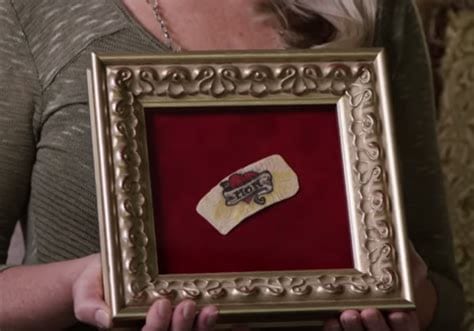
The tattoo industry in the United States is thriving. Thanks to the one in every five Americans who have at least a single patch, revenues have reached over $722 million in 2015. When business is booming, related services usually spring up to scoop their share of the craze. In recent years, a bizarre spinoff appeared in the tattoo world. This service allows people to frame their tattoos after death and bequeath it to someone.
The process works like this. A person pays for the service, called Save My Ink. After their customer dies, the company sends a kit to the funeral home. This package contains everything the staff there needs to remove the tattoos. The funeral home then sends the decorated skin to the National Association for the Preservation of Skin Art. In turn, NAPSA preserves and frames the tattoos before handing them over to the deceased’s loved ones. Many people might view this as a macabre inheritance but the NAPSA sales pitch begs to differ. The association said that heirloom tattoos represent the person’s story and legacy.[8]
For more on tattoos look no further than 10 Fascinating Facts About Tattoos, and Top 20 Worst Tattoos.








